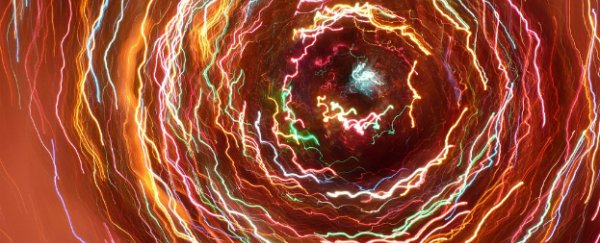In a world first, green twisted light has been beamed 3 km across Vienna, Austria, carrying three images of famous Austrians - physicists Erwin Schrödinger and Ludwig Boltzmann, and composer Wolfgang Amadeus Mozart.
While it may not sound that impressive, this technique could revolutionise the way we communicate information without cables - for example, they way we communicate between Earth and orbiting satellites - and make it far more rapid and secure.
At the moment when we talk with satellites, we use polarised light, which can only vibrate on a single plane, because it's not affected by turbulence in the air. But this is extremely slow, as only one bit of information can be carried by each particle of light.
In order to speed this up, physicists have been looking for a way to encode more information into photons - and in the '90s they began investigating twisting light, which can be sent like a corkscrew across long distances. This is known as orbital angular momentum, or OAM, and it opens up the potential for ridiculously fast and secure communication.
In theory, each photon - or particle of light - can be twisted in countless different ways, and each twist can carry a different piece of information. So this means that, using OAM, infinite amounts of data can be transferred at exactly the same time across long distances.
This is similar to what currently happens with different colours, or frequencies, of light inside optical fibres - but twisted light doesn't require any cables at all.
"The OAM of light is theoretically unbounded, meaning that one has, in theory, an unlimited amount of different distinguishable states in which light can be encoded," said study co-author Mario Krenn in a press release. "It is envisaged that this additional degree of freedom could significantly increase data-rates in classical communication."
In fact, in previous experiments, OAM has been used in optical fibres and has been able to send 2.5 terabits of data in just one second - that's more than 66 DVDs worth of information, as Jenna Iacurci reports for Nature World News.
In this experiment, however, the researchers didn't use any cables, and instead transferred the message directly through open air. It's the first time this has ever been done reliably across long distances. Their research is reported in the New Journal of Physics.
The physicists from the University of Vienna tested their twisted light by setting up a green laser at the window of a tower in Vienna, and shining it on a spatial light modulator. This device put four different levels of twists on photons, sending the beams of light corkscrewing through the night sky with the ability to carry four bits of information.
Once the connection had been established, the researchers digitised grayscale images of Mozart, Shrödinger and Boltzmann and broke them down into pixels. These pixels were then encoded as 16 patterns into the twisted green laser light and beamed to a receiving screen on the roof of their lab 3 km away.
This screen received the data, which appeared as a ring of dots. The number of dots was determined by how much the light was twisted, and using this information software then decoded the information back into an image.
Impressively, the images were received on the other side of the city with a tiny error rate of just 1.7 percent.
"We were definitely very surprised that it worked so well," Krenn, a PhD student at the university's Institute for Quantum Optics and Quantum Information, told Jonathan Webb for the BBC.
At this early stage, the transmission of their images didn't break any speed records - because they only had four twists to put on the light they could only send the images pixel by pixel and the whole thing took several minutes. Also, the technique they used wasn't OAM in the traditional sense, "but a superposition of two angular momentums, which go in opposite directions," Krenn told the BBC.
But they're the first to overcome the hurdles of sending twisted light across long distances outside and not having it be affected by turbulence, and that's a pretty huge deal.
"This is a proof of principle for how to encode and decode the 16 different channels," Michael Mazilu, a lecturer in the school of physics and astronomy at the University of St Andrews who wasn't involved in the research, told Webb over at the BBC. "It's a step towards encoding more information in less light."
Scientists also believe that twisted light could one day be used to create "unhackable" communication systems in the future.
Watch this video to find out more about the research:
Source: BBC, New Scientist, Nature World News
